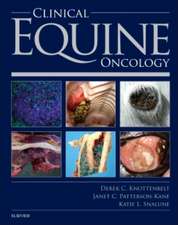Biofilms and Veterinary Medicine: Springer Series on Biofilms, cartea 6
Editat de Steven L. Percival, Derek C. Knottenbelt, Christine A. Cochraneen Limba Engleză Paperback – 27 noi 2013
In veterinary medicine the concept of biofilms and their role in the pathogenesis of disease has lagged seriously behind that in human medicine. This is all the more extraordinary when one considers that much of the research has been carried out using veterinary species in experimental situations. The clinical features of biofilms in human medicine is certainly mimicked in the veterinary species but there is an inherent and highly regrettable indifference to the failure of antimicrobial therapy in many veterinary disease situations, and this is probably at its most retrograde in veterinary wound management.
Biofilms and Veterinary Medicine is specifically focused on discussing the concerns of biofilms to health and disease in animals and provides a definitive text for veterinary practitioners, medical and veterinary students, and researchers.
| Toate formatele și edițiile | Preț | Express |
|---|---|---|
| Paperback (1) | 943.43 lei 6-8 săpt. | |
| Springer Berlin, Heidelberg – 27 noi 2013 | 943.43 lei 6-8 săpt. | |
| Hardback (1) | 947.35 lei 6-8 săpt. | |
| Springer Berlin, Heidelberg – 8 aug 2011 | 947.35 lei 6-8 săpt. |
Preț: 943.43 lei
Preț vechi: 1150.52 lei
-18% Nou
Puncte Express: 1415
Preț estimativ în valută:
180.58€ • 196.22$ • 151.79£
180.58€ • 196.22$ • 151.79£
Carte tipărită la comandă
Livrare economică 21 aprilie-05 mai
Preluare comenzi: 021 569.72.76
Specificații
ISBN-13: 9783642269974
ISBN-10: 3642269974
Pagini: 272
Ilustrații: XIV, 258 p.
Dimensiuni: 155 x 235 x 14 mm
Greutate: 0.39 kg
Ediția:2011
Editura: Springer Berlin, Heidelberg
Colecția Springer
Seria Springer Series on Biofilms
Locul publicării:Berlin, Heidelberg, Germany
ISBN-10: 3642269974
Pagini: 272
Ilustrații: XIV, 258 p.
Dimensiuni: 155 x 235 x 14 mm
Greutate: 0.39 kg
Ediția:2011
Editura: Springer Berlin, Heidelberg
Colecția Springer
Seria Springer Series on Biofilms
Locul publicării:Berlin, Heidelberg, Germany
Public țintă
ResearchCuprins
Introduction to Microbiology, Zoonoses and Antibiotics.- Introduction to biofilms.- Zoonotic related infections: The role of biofilms.- Biofilms and role to infection and disease in veterinary medicine.- Role of biofilms in oral health in animals.- Evidence and significance of biofilms in chronic wounds in horses.- Osteomyelitis in the Veterinary Species.- Biofilms and implication in medical devices in animals.- Bovine Mastitis and Biofilms.- Antimicrobial and biofilm resistance.
Textul de pe ultima copertă
Biofilms are implicated in many common medical problems including urinary tract infections, catheter infections, middle-ear infections, dental plaque, gingivitis, and some less common but more lethal processes such as endocarditis and infections in cystic fibrosis. However, the true importance of biofilms in the overall process of disease pathogenesis has only recently been recognized. Bacterial biofilms are one of the fundamental reasons for incipient wound healing failure in that they may impair natural cutaneous wound healing and reduce topical antimicrobial efficiency in infected skin wounds. Their existence explains many of the enigmas of microbial infection and a better grasp of the process may well serve to establish a different approach to infection control and management. Biofilms and their associated complications have been found to be involved in up to 80% of all infections. A large number of studies targeted at the bacterial biofilms have been conducted, and many of them are referred to in this book, which is the first of its kind. These clinical observations emphasize the importance of biofilm formation to both superficial and systemic infections, and the inability of current antimicrobial therapies to ‘cure’ the resulting diseases even when the in vitro tests suggest that they should be fully effective.
In veterinary medicine the concept of biofilms and their role in the pathogenesis of disease has lagged seriously behind that in human medicine. This is all the more extraordinary when one considers that much of the research has been carried out using veterinary species in experimental situations. The clinical features of biofilms in human medicine is certainly mimicked in the veterinary species but there is an inherent and highly regrettable indifference to the failure of antimicrobial therapy in many veterinary disease situations, and this is probably at its most retrograde in veterinary wound management.
Biofilms and Veterinary Medicine is specifically focused on discussing the concerns of biofilms to health and disease in animals and provides a definitive text for veterinary practitioners, medical and veterinary students, and researchers.
In veterinary medicine the concept of biofilms and their role in the pathogenesis of disease has lagged seriously behind that in human medicine. This is all the more extraordinary when one considers that much of the research has been carried out using veterinary species in experimental situations. The clinical features of biofilms in human medicine is certainly mimicked in the veterinary species but there is an inherent and highly regrettable indifference to the failure of antimicrobial therapy in many veterinary disease situations, and this is probably at its most retrograde in veterinary wound management.
Biofilms and Veterinary Medicine is specifically focused on discussing the concerns of biofilms to health and disease in animals and provides a definitive text for veterinary practitioners, medical and veterinary students, and researchers.
Caracteristici
Focused on discussing the concerns of biofilms to health and disease in animals Relates the characteristics of biofilms to veterinary science in order to assess their relevance to a wide range of diseases and infections found in animals Emphasizes the importance of biofilm formation to both superficial and systemic infections Includes supplementary material: sn.pub/extras

































